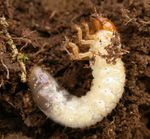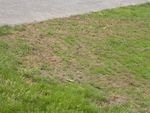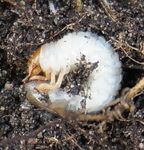European Chafer - Province of British Columbia
←
→
Page content transcription
If your browser does not render page correctly, please read the page content below
European Chafer
January 2020
A Pest Increasing its Range in British Columbia
The European Chafer, Rhizotrogus majalis, is a serious pest of turf,
horticulture, and field crops in Eastern North America. In 2001 it was
found in New Westminster, British Columbia, in lawns and boulevards.
It is slowly spreading and is now present throughout Vancouver,
Burnaby, and Coquitlam. It has been confirmed in east Richmond (2010)
and Delta (2007), and Surrey, and is spreading in these regions. In
December 2018, European Chafer was confirmed one location in the
city of Abbotsford, followed by confirmation in more areas of Figure 1. European Chafer adult beetles
Abbotsford in 2019 as well as several locations in Mission. On
Vancouver Island, European Chafer is confirmed in Nanaimo. The pest
has only been observed in urban areas and is not yet known to be
present in agriculture lands of British Columbia, however, detections
have been made adjacent to fields in Abbotsford and Richmond in 2019.
Description
The adult beetle (Figure 1) is tan coloured medium sized scarab beetle
(12 mm long). The larvae, or grubs (Figures 2, 5), have a C -shaped
body and brown head. Mature chafer grubs are up to 25 mm long,
significantly smaller than mature Ten-lined June beetle grubs, which can
be 5 cm long. A microscope is required to confidently identify the grubs
to species based on rastral hair patterns. There are several similar
beetle species present in British Columbia, which can be confused with Figure 2. European Chafer larval grub
European Chafer larvae or adults. These include the Ten-lined June
beetle (Polyphylla decemlineata) and other June beetles, Phyllophaga
species in the Scarabaeidae family. Native scarab beetles can be plant
pests but don’t tend to cause the extreme and rapid damage to turf
that European Chafer causes. The Japanese beetle (Popillia japonica) was
detected in the False Creek area of Vancouver in 2017, and eradication
efforts are underway. Its grubs can also severely damage turf.
Biology
The European Chafer completes a life cycle in one year. Eggs hatch
around mid-July, and the grubs moult twice over 8 weeks. The mature Figure 3. European Chafer damage to turf
grubs thrive in moist conditions and feed throughout the fall. During the winter they dig down during periods of freezing
conditions, but otherwise remain within 5 cm of the surface. They feed in the spring until April when they become
pupae. Adults emerge in late May and June, fly to nearby tall trees to mate, and subsequently females deposit up to 50
eggs each in exposed soil in nearby areas.Figure 4. European Chafer grubs in turf Figure 5. European Chafer larvae Damage The grubs are the damaging stage. They feed on all types of grass and, if numerous and food is scarce, may move into vegetable plantings to feed on corn, potatoes, blueberries, strawberries, conifers, and other crops. European chafer grubs prefer to feed on fibrous roots, and can damage ornamental and nursery plants by reducing their fibrous root system. Most of the damage is done by the third (final) instar grubs in the fall and early spring, but damage can be masked by the abundant moisture at these times. Drier weather can quickly result in the appearance of brown, dying patches in turf or other crops. Considerable damage to turf can occur in the fall and winter from animals, including skunks and birds digging up the grass to feed on the larger grubs (Figure 6). The adult beetles are active at dusk and can be seen clumsily walking across lawns and flying up into trees in groups, but adults do not cause damage. Monitoring To check for grubs, cut 3 sides of a 30 by 30 cm piece of sod to a depth of 5 cm, and fold it back to count the grubs. Generally if more than 20 grubs are found, control is warranted. Turf peels back easily if it is heavily infested, as the grubs have eaten off the roots. Check under dead or dying patches of turf, or where there has been damage to turf by vertebrates (mammals, birds). Management Healthy, vigorous, well-irrigated turf can withstand low levels of grub feeding. Mow at 6-9 cm height, as taller turf is less preferred by egg-laying female beetles, and is more drought-tolerant. Although birds and mammals feeding on larvae damages turf, it also helps decrease the pest population. Do not reseed until feeding is completed and grubs have pupated in the spring. There are some naturally occurring soil organisms that infect European chafer larvae and make them sick or kill them, reducing their impact. However, these cannot be relied on to completely manage a chafer infestation.
Conventional insecticides and predatory nematodes are available for grub control. Both types of
products work best if applied when grubs are small; from mid-July until September. Local studies show
that Heterorhabditis bacteriophora is the best nematode choice (one trade name is Nemasys G). This
nematode is a "cruiser" species that actively seeks out white grubs such as the European chafer, and
quickly destroys them from the inside-out. Insecticides containing imidacloprid, chlorantraniliprole, and
clothianidin are available in commercial formulations, which can only be applied by commercial
applicators. Check with your municipality to ensure you are aware of local pesticide use bylaws and
recommendations in addition to provincial and federal regulations.
Figure 6: Dying turf from larvae feeding, and damage caused by vertebrates (racoons, skunks) digging out
grubs
Insecticides or nematodes can also be applied successfully to non-frozen turf in the fall, spring, and
summer, when soil is moist and warm and the grubs are active. Before applying treatments, remove
excessive thatch and irrigate to a depth of 2-5 cm if the soil is dry. For both insecticides and nematodes,
it is important to irrigate or ‘water in’ after treatment to move the product into the root zone. If hiring
a commercial applicator to apply insecticides or nematodes, check with the applicator to determine if
you need to irrigate after the treatment, and how much water to apply.
In 2019, a new microbial product that suppresses pests such as European Chafer is now registered and
available in Canada. The active ingredient is Bacillus thuringiensis galleriae, which kills larvae or beetles
when they eat it. Commercial product names are BeetleGONE! and GrubGONE! which need to be
applied by a commercial applicator. The domestic product which should be available at some garden
centers for homeowners to purchase and apply is called Grub B Gon, by Scott’s.
If you have an ongoing problem with European chafer, consider employing a commercial lawn care
company to help manage the problem annually. Alternatively, remove turf from chafer-prone areas and
replace with an alternative landscape feature. Do not remove soil from infested areas, as chafer can be
spread to new areas by movement of infested soil. Do not import plants from infested areas.
Composting will not kill larvae.
Further Information:
• Grubs in Lawns, Ontario Ministry of AgricultureYou can also read

























































